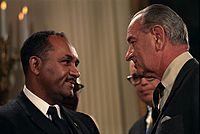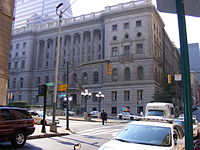- Clarence M. Mitchell, Jr.
-
Clarence M. Mitchell, Jr. (March 8, 1911 - March 19, 1984) was a civil rights activist and was the chief lobbyist for the NAACP for nearly 30 years.[1] He also served as a regional director for the organization. Mitchell, nicknamed "the 101st U.S. Senator", waged a tireless campaign on Capitol Hill to secure the passage of a comprehensive series of civil rights laws: the 1957 Civil Rights Act, the 1960 Civil Rights Act, the 1964 Civil Rights Act, the 1965 Voting Rights Act and the 1968 Fair Housing Act.[2] In 1969 he won the Spingarn Medal for these efforts. Later he faced some criticism in the black community for supporting Daniel Patrick Moynihan (see Assistant Secretary of Labor; controversy over the War on Poverty) and defending the state of Israel. On June 9, 1980, he was presented with the Presidential Medal of Freedom by President Jimmy Carter. After his retirement, he wrote a Sunday editorial column for The Baltimore Sun, every Sunday, until he died in 1984. The Sun called it "an extraordinary commentary on the civil rights movement." On March 23, 1984, the Sharp Street Memorial United Methodist Church overflowed with 2,500 mourners who gathered from around the country to pay their respects. Included among them was Harry R. Hughes, the Governor of Maryland, William Donald Schaefer, the Mayor of Baltimore, Benjamin Hooks, director of the NAACP, and Dorothy Height, president of the National Council of Negro Women. A week after his death, the newspaper proposed that there be a physical memorial to Mitchell. Mayor Schaefer agreed and appointed a commission to study the recommendation.[3] Today, the main court house[4] in Baltimore City has been renamed the Clarence M. Mitchell, Jr. Courthouse as well as a 35,000-square-foot (3,300 m2) building that houses the engineering program at Morgan State University. He was a member of the University of Maryland Board of Regents, from 1982 to 1984. The main admission building at the University is named after him (Mitchell Building).
Contents
Family
Clarence M. Mitchell, Jr. was married to Juanita Jackson Mitchell, Esq. who was an NAACP activist and the first African-American female admitted to practice law in the State of Maryland and the daughter of Baltimore NAACP leader Dr. Lillie Carroll Jackson. His father, Clarence M. Mitchell, Sr., was a waiter and his mother, Elsie Davis Mitchell was a homemaker. Mitchell's brother, Parren Mitchell was a congressman from Maryland. The Mitchell's sons Clarence M. Mitchell, III and Michael B. Mitchell, Sr. both served as Baltimore City councilmen and later, Maryland State Senators. The Mitchells' grandsons also are involved in Baltimore politics. Clarence M. Mitchell, IV was a Maryland State Senator from Maryland's 44th legislative district. Keiffer J. Mitchell, Jr. was a Baltimore City Councilman and currently serves as a Maryland State Delegate from the 44th district.
Childhood
Clarence Mitchell’s life as a child was a humble one. Raised in a large family that would have been larger if not for the death of a sibling that was born before him and two that died when he was young, the Mitchells had a total of seven children and nine mouths to feed, 11 including his maternal grandparents. According to the US Census in 1910[5]; his mother’s parents lived with the family, and they both died in 1912 and 1913. Mitchell was moved around as a youngster, living in rented homes in the same area of Baltimore City until the family purchased their own home in 1929 at 712 Carrollton Avenue in Baltimore’s Harlem Park neighborhood. As a child, Mitchell saw the hardships his family faced, and even watched his mother, Elsie Davis Mitchell, take in laundry and table boarders to supplement his father’s income from working at the Rennert Hotel. A religious woman, Mitchell’s mother attended church at St. Katherine’s Episcopal Church on Division St. in Baltimore, where Mitchell and his brother served in the services on Sunday mornings. Christmas was very important to the family, as was cleanliness. Mitchell often spoke of the way his mother took care to decorate the house during the holiday, and also remembers how the yard and the fence were ordered to remain as tidy as possible. Mitchell was taught by his parents not to “take anything from anyone” when it came to racial issues, and the credo that each older child taught the younger children what they knew led in the passing of that motto to all of the Mitchell children. As a child, Clarence spent time at the YMCA learning how to box, earning himself the nickname “the Shamrock Kid”. Mitchell, as others who knew him as a young person recall, was an honest person. At his jobs at the many hotels and restaurants he worked at, he never gave in to the opportunity to steal food and take it home, even though everyone knew the financial status of his family.
Mitchell excelled in his early education, working hard to study the lessons his illiterate mother somehow taught him. When Mitchell was in elementary school, one of his teachers was the mother of another famous Baltimorean, Thurgood Marshall. Clarence Mitchell, Jr. worked many menial and odd jobs throughout his childhood; from hauling ice and coal in a wagon for money as a young boy, which he subsequently gave to his parents to support the household; to working with Thurgood Marshall and Marshall's father as a busboy at the Gibson Island Club.[6]
Education
Mitchell attended the Old Douglass High School, and then went on to school at Lincoln University in Pennsylvania, where he excelled in his studies and was known as quite a prankster. Mitchell also attended the University of Minnesota after which he became the executive secretary for the Urban League in St. Paul in 1937. While in Minnesota, he led a successful campaign to end employment discrimination practices against African-Americans who worked for the city of St.Paul.[7]
Career
Mitchell’s decision to advocate civil rights possibly stemmed from his work for the Baltimore Afro-American, a newspaper he did journalistic work for as a young man. Mitchell wrote articles about the infamous Scottsboro case, and also on the lynching of a black man in Cambridge, on Maryland’s Eastern Shore. While Mitchell missed the lynching itself, he was there in time to see the fanatical crowd douse the body with gasoline, set it ablaze and drag it through the black neighborhood in the city. When Mitchell came home and recalled the story, his brother Parren Mitchell also decided that he too, one day, would take up the fight for equality among all races.[8]
Clarence picked up the ability to write his own poetry as a young child, due largely to his mother's orders for the children to go to the library as much as possible and read whatever they could get their hands on. He wrote poems to his siblings and also wrote the song for his graduating class at Lincoln, although he was not able to graduate on stage himself because of an inability to pay past tuition. Mitchell also wrote a poem called “A Star is a Small Reward” which was published in the Afro-American when his mother died in November 1959. Mitchell must have gotten his tirelessness from his mother, because in that same year, Mitchell lost his father to cancer in June and his brother Lorenzo to a car accident. Elsie Davis Mitchell was so determined, although she was confined to bed, to attend her son Lorenzo's funeral at St. Katherine’s without a wheelchair that she had her children carry her into the church for the service.
Legacy
Clarence Mitchell, Jr. is as well know today in Baltimore as he was when he was alive. The building that houses the Baltimore Circuit Court and the Office of the Baltimore State's Attorney was named in his honor. His efforts in the civil rights arena are chronicled in a book: "Lion in the lobby : Clarence Mitchell, Jr.’s struggle for the passage of civil rights laws" published in 2002.[9] Mitchell is included in the book "Marylanders of the Century", written by Joseph R. L. Sterne, retired editor of The Baltimore Sun’s editorial pages who covered the civil rights struggle in Washington during the 1960s.[10]
References
- ^ The New Crisis via find articles
- ^ Library of Congress on the Mitchell family
- ^ Sterne, Joseph R. L., editor, Sun Magazine Special Edition Clarence M. Mitchell, Jr., A Vision of Justice, A legacy of Humanity, 1911-1984. Baltimore: The Baltimore Sun, 1985. p. 2
- ^ Courthouse Plan Mapped, Renovation Program Recommended To Mayor, Baltimore (Morning) Sun, Wednesday, November 6, 1946
- ^ 1910 Census, United States Bureau of the Census
- ^ Denton L. Watson,Lion in the Lobby:Clarence Mitchell, Jr.'s Struggle for the Passage of Civil Rights Laws, New York: Morrow Publishers, 1990
- ^ Jones, Melissa (6 March 2011). "Clarence Mitchell Jr: Dedicated to Making a Better World". Baltimore Afro-American. http://www.afro.com/sections/news/baltimore/story.htm?storyid=4169. Retrieved 6 March 2011.
- ^ "Mitchell Family" Vertical Files: Maryland Room Collection, Enoch Pratt Free Library Baltimore, MD
- ^ Watson, Denton L. (2002). Lion in the lobby. Lanham, MD: University Press of America. ISBN 0761822119. http://catalog.umd.edu/F/BU6Q94XQJVRSSJ25B4HD64475RN4MY23S6ARU22UHCIRD7CUT7?func=find-c&ccl_term=sys%3D002661796.
- ^ "Clarence Mitchell, Jr., Papers". SUNY College at Old Westbury. http://www.oldwestbury.edu/faculty_pages/watson/mitchellpapers.htm. Retrieved 6 March 2011.
Primary sources
- The Papers of Clarence Mitchell Jr., Volume III: NAACP Labor Secretary and Director of the NAACP Washington Bureau, 1946-1950; Volume IV: Director of the NAACP Washington Bureau, 1951-1954 edited by Denton L. Watson (Ohio University Press; 2010) 768 pages
External links
Categories:- 1911 births
- 1984 deaths
- African Americans' rights activists
- American lobbyists
- National Association for the Advancement of Colored People
- Spingarn Medal winners
- 20th-century African-American activists
Wikimedia Foundation. 2010.




